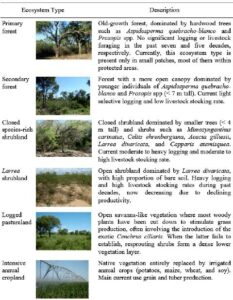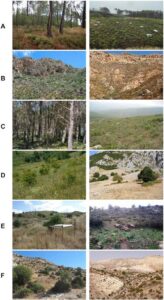Back to: Botany 300 Level
Hello, my wonderful Afrilearn scholar! How are you doing today? I hope you’re ready for another exciting lesson! Have you ever wondered how human activities affect the environment around us? Today, we’re going to focus on forests and grasslands, two of the world’s most important ecosystems. We’ll explore how human actions like deforestation, urbanisation, and agriculture are impacting these ecosystems and what it means for the plants, animals, and people that depend on them.
Human impact on forest and grassland ecosystems
Human Impact on Forest Ecosystems
Forests, as we’ve seen, are essential to life on Earth. They provide oxygen, regulate climate, protect water resources, and support incredible biodiversity. However, human activities have dramatically affected forests, especially in countries like Nigeria, where forests are being destroyed at an alarming rate.
1. Deforestation
Deforestation refers to the cutting down or clearing of forests, often to make way for agriculture, urbanisation, or timber extraction. In Nigeria, large areas of the Cross River Rainforest and other tropical forests have been cleared for farming, logging, and infrastructure development.

Impact of Deforestation on Forests
Loss of Biodiversity – When forests are destroyed, the species that depend on them lose their habitats. This leads to a decline in wildlife populations, including important species like the chimpanzee and the forest elephant.
Climate Change – Trees absorb carbon dioxide and release oxygen, so when they are cut down, carbon is released into the atmosphere, accelerating global warming.
Soil Erosion – Without tree roots to hold the soil together, the land becomes vulnerable to erosion. This leads to loss of fertile soil, which affects farming and local communities.
Disruption of Water Cycles – Forests regulate local weather patterns and rainfall. Deforestation can lead to changes in rainfall patterns, causing droughts in some areas and floods in others.
2. Illegal Logging and Timber Trade
Illegal logging, where trees are cut down and sold without proper regulation, is another major threat to forests. In Nigeria, forests are often illegally harvested for timber to support the booming construction and furniture industries. This contributes to further forest degradation and loss of habitat for countless species.
Impact of Illegal Logging
Destruction of Ecosystems – Timber extraction often causes large-scale clearing of forest land, affecting everything from small insects to large mammals.
Economic Loss – Although timber may generate short-term profits, the long-term consequences of ecosystem loss are felt by local communities and the nation as a whole, especially when resources like water and fertile land become scarce.
Human Impact on Grassland Ecosystems
Grasslands, like the savannas and steppes, are important ecosystems that support grazing animals, agriculture, and local communities. However, human activities are also having a significant impact on these ecosystems.
1. Overgrazing
In many parts of Nigeria, especially in the northern regions, livestock herders like the Fulani depend on grasslands for grazing cattle, goats, and sheep. Overgrazing occurs when too many animals graze on the land, preventing grasses from regenerating properly.
Impact of Overgrazing
Soil Degradation – When animals eat too much grass, the soil becomes compacted, and its ability to absorb water decreases. This leads to desertification, where once-productive land turns into dry, barren desert.
Loss of Plant Species – Overgrazing reduces the diversity of grasses, leading to monocultures (single species of plants) that are less resilient to diseases and pests.
Food Scarcity – As grasslands degrade, both humans and animals face a shortage of food, which can lead to famine or malnutrition in communities that depend on these lands.
2. Agricultural Expansion
As populations grow, people expand agricultural lands to meet the increasing demand for food. In Nigeria, large areas of grasslands are being converted into farmland for crops like maize, cassava, and groundnuts.
Impact of Agricultural Expansion
Habitat Loss – Expanding agriculture means destroying grasslands that once supported a variety of animals, such as zebras, gazelles, and lions.
Chemical Pollution – The use of fertilisers and pesticides in agriculture can pollute the surrounding environment, affecting soil health and water quality.
Reduction in Biodiversity – As natural vegetation is replaced with monocultures, the variety of plant and animal species in grasslands decreases, leading to weakened ecosystems that are less resilient to pests, diseases, and changing climates.
3. Urbanisation and Infrastructure Development
In some cases, the conversion of grasslands into cities, towns, and roads is a major problem. As Nigeria continues to urbanise, areas of grassland are being developed for housing, factories, and transportation networks.
Impact of Urbanisation
Loss of Wildlife Habitats – Urbanisation destroys the natural homes of many species, leaving them without food, shelter, or safe places to breed.

Pollution – Cities produce air, water, and soil pollution, which affects surrounding ecosystems, including grasslands.
Fragmentation of Ecosystems – Urban areas can fragment ecosystems, making it difficult for species to migrate or access the resources they need to survive.
Summary
Human activities have had a significant impact on both forest and grassland ecosystems. The destruction of these ecosystems has led to:
Loss of biodiversity – Many plants and animals are losing their homes.
Climate change – Deforestation and overgrazing contribute to global warming.
Soil erosion and degradation – The land becomes less fertile and more prone to disasters.
Food and water scarcity – Degraded ecosystems can no longer support local communities as they once did.
It’s important that we recognise these impacts and work towards sustainable practices to protect and restore these vital ecosystems.
Evaluation
- What is deforestation, and how does it impact forest ecosystems?
- How does overgrazing affect grassland ecosystems?
- What role does illegal logging play in the destruction of forests?
- How does urbanisation harm grassland ecosystems?
- Why is it important to protect forests and grasslands?
You’re doing wonderfully well! Keep up the great work! Now that you understand the significant impact humans have on forests and grasslands, it’s up to us to change our ways and work together to protect our environment. Stay excited for the next lesson, and keep learning! You’re making fantastic progress!
